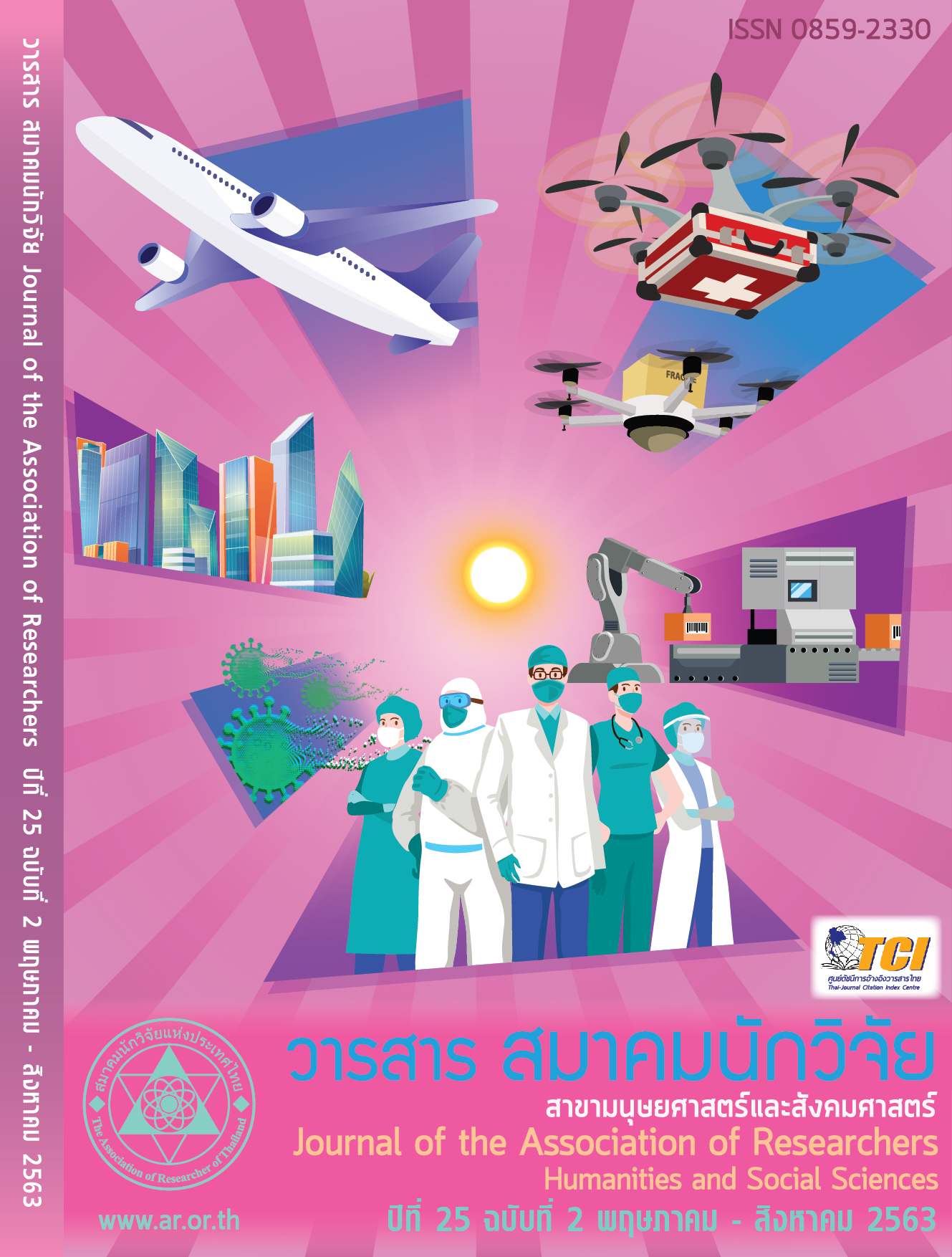Evaluation of the Performance of the English Program Department
Main Article Content
Abstract
English Program in Thai schools is a semi-independent hybrid of the Thai Program and International Program to provide alternatives for teaching and learning the English language in schools. The blended concepts and specialized standards draw interests to parents, students, and teachers. It’s a relatively amateur program and is becoming a trend in both private and public schools. Being a young organization, disputes arise with its performance. Evaluation research was conducted to examine the degree of the EP’s organizational performance as assessed by the stakeholders and explore how can EP ensure that stakeholders will commit to facilitating a favorable EP performance. The study utilized the sequential explanatory design of the mixed-method approach guided by the concepts of “Organizations, Structures, Processes, and Outcomes” (Harper, 2015) directed with Miller’s (2016) blueprint of “Assessing Organizational Performance in Higher Education”. The performance was evaluated for a designated unit of analysis (Miller, 2016). A thorough investigation of the functional communication among stakeholders, stakeholders’ participation, and stakeholders’ commitment to supporting EP provided detection that different stakeholders have different confrontations. The study can be used as a reliable foundation to acknowledge its current condition. The study may serve as a mirror for other schools with EP programs to review their existing organizational performance and conceivably improve it. Other established EP departments from other schools may also share their best practices and serve as guidelines for newly established EP departments. The result of the study provided information for the formulation of favorable mechanisms to further improve the performance of the EP department.
Article Details
บทความที่ปรากฏในวารสารนี้ เป็นความรับผิดชอบของผู้เขียน ซึ่งสมาคมนักวิจัยไม่จำเป็นต้องเห็นด้วยเสมอไป การนำเสนอผลงานวิจัยและบทความในวารสารนี้ไปเผยแพร่สามารถกระทำได้ โดยระบุแหล่งอ้างอิงจาก "วารสารสมาคมนักวิจัย"
References
Alanezi, A. S. (2015). Communication Satisfaction and Its Relationship to Organizational Commitment Among Secondary Teachers in Kuwait.
Atmojo, M. (2015). The Influence of Transformational Leadership on Job Satisfaction, Organizational Commitment, and Employee Performance. International research journal of business studies, 5(2).
Ashraf, G. (2012). A Review on the Models of Organizational Effectiveness: A Look at Cameron's Model in. International Education Studies, 5(2), 80.
Bhaskar, A. (2016). HRM Practices on Organizational Commitment of Employees and its Impact. Indian Journal of Applied Research, 6(1).
Burton, D. R. (2015). The Use of English in a School of Medicine in Thailand.
Chang, Y., Leach, N., & Anderman, E. M. (2015). The Role of Perceived Autonomy Support in Principals’ Affective Organizational Commitment and Job Satisfaction. Social Psychology of Education, 18(2), 315-336.
Crawford-Patterson, V. T. (2008). An Investigation of the Principal’s Communication in the COMER SCHOOL DEVELOPMENT MODEL.
Darbi, W. P. K. (2012). Of Mission and Vision Statements and their Potential Impact on Employee Behaviour and Attitudes: The Case of a Public but profit-oriented Tertiary Institution. International Journal of Business and Social Science, 3(14).
Dhar, R. L. (2015). Service Quality and the Training of Employees: The Mediating Role of Organizational Commitment. Tourism Management, 46, 419-430.
Dou, D., Devos, G., & Valcke, M. (2015). Exploring the Effects of Principal Leadership, School Climate, Teachers' Psychological Factors on Teachers' Job Satisfaction and Organizational Commitment. In 7th International Conference on Education and New Learning Technologies (pp. 8113-8121). IATED.
Dudley, L. (2010). Defining Performance. Blog: Training and Development. Free Management Library.
Gillet, N., Forest, J., Benabou, C., & Bentein, K. (2015). The Effects of Organizational Factors, Psychological Need Satisfaction and Thwarting, and Affective Commitment on Workers’ Well-being and Turnover Intentions. Le travail humain, 78(2), 119-140.
Griffin, R. W. (2006). Fundamentals of Management. Fourth Edition. Boston, New York: Houghton Mifflin Company
Harper, C. (2015). Organizations: Structures, Processes, and Outcomes. Routledge.
Hayes, D. (2016). The Value of Learning English in Thailand and its Impact on Thai: Perspectives From University Students. Asia Pacific Journal of Education, 36(1), 73-91.
James, L. (2012). What is Organisational Performance? Pitcher Partners Growth. Growing Great Businesses.
Karanges, E., Johnston, K., Beatson, A., & Lings, I. (2015). The Influence of Internal Communication on Employee Engagement: A Pilot Study. Public Relations Review, 41(1), 129-131.
Kaur, A., Young, D., & Kirkpatrick, R. (2016). English Education Policy in Thailand: Why the Poor Results?. In English Language Education Policy in Asia (pp. 345-361). Springer International Publishing.
Khanna, S., & Gupta, V. (2016). The Impact of Psychological Empowerment on Job Satisfaction and Organizational Commitment. International Journal of Research in Organizational Behavior and Human Resource Management, 4(1), 24-36.
Keyuravong, S. (2010). Insights from THAILAND. Learning through English: Policies, Challenges, and Prospects: Insights from East Asia, 69-95.
March, J. G., & Sutton, R. I. (1997). Crossroads-Organizational Performance as a Dependent Variable. Organization Science, 8(6), 698-706.
Martz, W. A. (2008). Evaluating Organizational Effectiveness. ProQuest.
Miller, B. A. (2016). Assessing Organizational Performance in Higher Education. John Wiley & Sons.
Nakpodia, E. D. (2010). The Influence of Communication on Administration of Secondary Schools in Delta State, Nigeria. International NGO Journal, 5(8), 194-198.
Niemted, W. (2016). The important factors of English Program administration responsive to the ASEAN community for schools in the border provinces of southern Thailand. Kasetsart Journal of Social Sciences, 37(3), 158-163.
Othman, R., & Abd Rauf, F. (2009). Implementing the School Performance Index (SPIn) in Malaysian Primary Schools. International Journal of Educational Management, 23(6), 505-522.
Rajprasit, K., Pratoomrat, P., & Wang, T. (2015). Perceptions and Problems of English language and Communication Abilities: A Final Check on Thai Engineering Undergraduates. English Language Teaching, 8(3), 111.
Suwannoppharat, K., & Chinokul, S. (2015). Applying CLIL to English Language Teaching in Thailand: Issues and Challenges/La aplicación del AICLE para la enseñanza del idioma inglés en Tailandia: asuntos y retos. Latin American Journal of Content & Language Integrated Learning, 8(2), 237.
Taylor, P. (2013). Communities of Practice: Identity and Participation in a Workplace English Language Training Classroom in Thailand: A Community of Practice Perspective. Doctoral Dissertation. The University of Nottingham.
Williams, C. (2008). Effective Management. Third Edition. The United States of America. Thomson South-Western, a part of The Thomson Corporation.
Winter, R.G.(2011). Part-Whole Science. Synthese. 178:397.doi:10.1007/s11229-009-9647-0.


